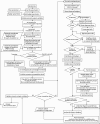Emergency rabies control in a community of two high-density hosts
- PMID: 22709848
- PMCID: PMC3492034
- DOI: 10.1186/1746-6148-8-79
Emergency rabies control in a community of two high-density hosts
Abstract
Background: Rabies is a fatal viral disease that potentially can affect all mammals. Terrestrial rabies is not present in the United Kingdom and has been eliminated from Western Europe. Nevertheless the possibility remains that rabies could be introduced to England, where it would find two potentially suitable hosts, red foxes and badgers. With the aim to analyse the spread and emergency control of rabies in this two species host community, a simulation model was constructed. Different control strategies involving anti-rabies vaccination and population culling were developed, considering control application rates, spatial extent and timing. These strategies were evaluated for efficacy and feasibility to control rabies in hypothetical rural areas in the South of England immediately after a disease outbreak.
Results: The model confirmed that both fox and badger populations, separately, were competent hosts for the spread of rabies. Realistic vaccination levels were not sufficient to control rabies in high-density badger populations. The combined species community was a very strong rabies host. However, disease spread within species appeared to be more important than cross-species infection. Thus, the drivers of epidemiology depend on the potential of separate host species to sustain the disease. To control a rabies outbreak in the two species, both species had to be targeted. Realistic and robust control strategies involved vaccination of foxes and badgers, but also required badger culling. Although fox and badger populations in the UK are exceptionally dense, an outbreak of rabies can be controlled with a higher than 90% chance, if control response is quick and follows a strict regime. This requires surveillance and forceful and repeated control campaigns. In contrast, an uncontrolled rabies outbreak in the South of England would quickly develop into a strong epizootic involving tens of thousands of rabid foxes and badgers.
Conclusions: If populations of both host species are sufficiently large, epizootics are driven by within-species transmission, while cross-species-infection appears to be of minor importance. Thus, the disease control strategy has to target both host populations.
Figures





Similar articles
-
Emergency vaccination of rabies under limited resources -- combating or containing?BMC Infect Dis. 2005 Mar 7;5:10. doi: 10.1186/1471-2334-5-10. BMC Infect Dis. 2005. PMID: 15752423 Free PMC article.
-
The spatio-temporal dynamics of a post-vaccination resurgence of rabies in foxes and emergency vaccination planning.Prev Vet Med. 1999 Oct 19;47(1-2):1-21. doi: 10.1016/s0167-5877(00)00167-7. Prev Vet Med. 1999. PMID: 11018731
-
Modeling control of rabies outbreaks in red fox populations to evaluate culling, vaccination, and vaccination combined with fertility control.J Wildl Dis. 2003 Apr;39(2):278-86. doi: 10.7589/0090-3558-39.2.278. J Wildl Dis. 2003. PMID: 12910754
-
Round table on epidemiology and control of fox rabies.Vet Microbiol. 1992 Nov;33(1-4):297-301. doi: 10.1016/0378-1135(92)90057-z. Vet Microbiol. 1992. PMID: 1481362 Review.
-
Oral vaccination of wildlife against rabies: opportunities and challenges in prevention and control.Dev Biol (Basel). 2004;119:173-84. Dev Biol (Basel). 2004. PMID: 15742629 Review.
Cited by
-
Spatial Landscape Structure Influences Cross-Species Transmission in a Rabies-like Virus Model.Microorganisms. 2025 Feb 14;13(2):416. doi: 10.3390/microorganisms13020416. Microorganisms. 2025. PMID: 40005781 Free PMC article.
-
Spatial Aspects of Gardens Drive Ranging in Urban Foxes (Vulpes vulpes): The Resource Dispersion Hypothesis Revisited.Animals (Basel). 2020 Jul 9;10(7):1167. doi: 10.3390/ani10071167. Animals (Basel). 2020. PMID: 32660022 Free PMC article.
-
Garden Scraps: Agonistic Interactions between Hedgehogs and Sympatric Mammals in Urban Gardens.Animals (Basel). 2023 Feb 8;13(4):590. doi: 10.3390/ani13040590. Animals (Basel). 2023. PMID: 36830377 Free PMC article.
-
A citizen science based survey method for estimating the density of urban carnivores.PLoS One. 2018 May 22;13(5):e0197445. doi: 10.1371/journal.pone.0197445. eCollection 2018. PLoS One. 2018. PMID: 29787598 Free PMC article.
-
Patterns of animal rabies in the Nizhny Novgorod region of Russia (2012-2022): the analysis of risk factors.Front Vet Sci. 2024 Oct 22;11:1440408. doi: 10.3389/fvets.2024.1440408. eCollection 2024. Front Vet Sci. 2024. PMID: 39502946 Free PMC article.
References
-
- Smith GC. The role of the badger (Meles meles) in rabies epizootiology and the implications for Great Britain. Mammal Rev. 2002;32:13–26.
-
- WHO. WHO expert consulatation on rabies. Geneva: World Health Organisation; 2004.
-
- Holmala K, Kauhala K. Ecology of wildlife rabies in Europe. Mammal Rev. 2006;36:17–36. doi: 10.1111/j.1365-2907.2006.00078.x. - DOI
Publication types
MeSH terms
Substances
LinkOut - more resources
Full Text Sources
Medical

